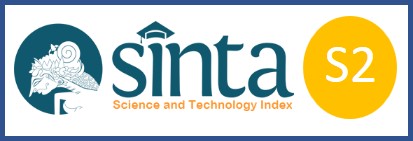Poverty Line Based on the Large Archipelagic Area in Indonesia in Taking Poverty Alleviation Policies
Downloads
Various efforts to overcome poverty have been carried out by the government but the number of poor people is still quite high. Based on the 1945 Constitution, the Indonesian government has a mandate to realize social welfare for all people. Well-being is characterized by the fulfillment of the material, spiritual, and social needs of citizens. In other words, prosperity can be achieved through poverty alleviation. In alleviating poverty, existing policies have not interpreted the poverty line based on division in Indonesia. This study analyzes more deeply the role of urban and rural poverty lines in the division of regions in Indonesia. The method used is descriptive statistics by grouping provinces into 7 categories of large islands in Indonesia. In addition, the MANOVA analysis method was also used in this study to answer the role of the region on the size of the poverty line. What is interesting about this study is the finding that regional differences play a significant role in influencing the size of the poverty line. This research also revealed the fact that the poverty line gap between regional categories is wide at a significance level below 0.05 in the MANOVA test of between subjects effects.
Afira, N., & Wijayanto, A. W. (2021). Analisis Cluster dengan Metode Partitioning dan Hierarki pada Data Informasi Kemiskinan Provinsi di Indonesia Tahun 2019 [Cluster Analysis using Partitioning and Hierarchy Methods on Provincial Poverty Information Data in Indonesia in 2019]. Komputika : Jurnal Sistem Komputer, 10(2), 101–109. https://doi.org/10.34010/komputika.v10i2.4317
Aprilia, K., & Sembiring, F. (2021). Analisis Garis Kemiskinan Makanan Menggunakan Metode Algoritma K-Means Clustering [Analysis of the Food Poverty Line Using the K-Means Clustering Algorithm Method]. Seminar Nasional Sistem Informasi Dan Manajemen Informatika, 1(1). 1–10.
Arifin, J. (2020). Budaya Kemiskinan Dalam Penanggulangan Kemiskinan Di Indonesia [The Culture of Poverty in Overcoming Poverty in Indonesia]. Sosio Informa, 6(2). 114–132. https://doi.org/10.33007/inf.v6i2.2372
BPS. (2022). Perdagangan Antar Wilayah Indonesia [Perdagangan Antar Wilayah Indonesia]. Central Bureau of Statistics.
BPS. (2023). Profil Kemiskinan di Indonesia September 2023 [Poverty Profile in Indonesia September 2023]. Berita Resmi Statistik.
Chancel, L., Piketty, T., Saez, E., & Zucman, G. (2022). World Inequality Report 2022. World Inequality Lab.
Faradis, R., & Afifah, U. N. (2020). Indeks Komposit Pembangunan Infrastruktur Provinsi-Provinsi di Indonesia [Composite Index of Infrastructure Development for Provinces in Indonesia]. Jurnal Ekonomi Dan Pembangunan Indonesia, 20(1). 33-55. https://doi.org/10.21002/jepi.2020.03
Ferezagia, D. V. (2018). Analisis Tingkat Kemiskinan di Indonesia [Analysis of Poverty Levels in Indonesia]. Jurnal Sosial Humaniora Terapan, 1(1), 1–6. https://scholarhub.ui.ac.id/jsht/vol1/iss1/1/
Friedmann, J. (2019). Thinking about complexity and planning. International Planning Studies, 24(1), 13–22. https://doi.org/10.1080/13563475.2018.1517594
Ghozali, I. (2009). Analisis multivariate lanjutan dengan program SPSS [Advance multivariate analysis with the SPSS program]. Badan Penerbit Universitas Diponegoro.
Islam, R., Ghani, A. B. A., Abidin, I. Z., & Rayaiappan, J. M. (2017). Impact on poverty and income inequality in Malaysia's economic growth. Problems and Perspectives in Management, 15(1), 55–62. https://doi.org/10.21511/ppm.15(1).2017.05
Murdiyana, M., & Mulyana, M. (2017). Analisis Kebijakan Pengentasan Kemiskinan Di Indonesia [Analysis of Poverty Alleviation Policy in Indonesia]. Jurnal Politik Pemerintahan Dharma Praja, 10(1), 73–96. https://doi.org/10.33701/jppdp.v10i1.384
Ningsih, D., & Andiny, P. (2018). Analisis Pengaruh Inflasi Dan Pertumbuhan Ekonomi Terhadap Kemiskinan Di Indonesia [Analysis the Effect of Inflation and Economic Growth on Poverty in Indonesia]. Jurnal Samudra Ekonomika, 2(1), 53–61. https://doi.org/10.1234/jse.v2i1.777
Pynanjung, P. A., Agustinus, E., Junaidi, J., Burhansyah, R., & Oktoriana, S. (2021). Poverty in the Indonesia-Malaysia border province (case study in West Kalimantan Province). Jurnal Perspektif Pembiayaan Dan Pembangunan Daerah, 9(5), 401–412. https://doi.org/10.22437/ppd.v9i5.12760
Saragih, J. (2015). Kebijakan Pengentasan Kemiskinan Di Daerah Istimewa Yogyakarta [Government Policy to Reduce Poverty in the Special Region of Yogyakarta]. Jurnal Ekonomi Dan Kebijakan Publik, 6(1), 45–59.
Setiawan, A. (2019). Analisis Perbedaan Tingkat Kemiskinan dan Ketimpangan Perdesaan Sebelum dan Sesudah Digulirkannya Dana Desa [Analysis of Differences in Poverty Levels and Rural Inequality Before and After the Village Funds are Revolved]. Akuntabel, 16(1), 31–35.
Sumargo, B., Miduk, N., & Simanjuntak, M. (2019). Deprivasi Utama Kemiskinan Multidimensi Antarprovinsi di Indonesia [Main Deprivation of Multidimensional Poverty among Provinces in Indonesia]. Jurnal Ekonomi Dan Pembangunan Indonesia, 19(2), 160–172. https://doi.org/10.21002/jepi.2019.10
Copyright (c) 2023 Royhan Faradis, Uswatun Nurul Afifah

This work is licensed under a Creative Commons Attribution-ShareAlike 4.0 International License.
JIET (Jurnal Ilmu Ekonomi Terapan) (p-ISSN: 2541-1470; e-ISSN: 2528-1879) is licensed under a Creative Commons Attribution-ShareAlike 4.0 International License
Authors who publish with JIET (Jurnal Ilmu Ekonomi Terapan) agree to the following terms:
- The journal allows the author to hold the copyright of the article without restrictions.
- The journal allows the author(s) to retain publishing rights without restrictions
- The legal formal aspect of journal publication accessibility refers to Creative Commons Attribution ShareAlike 4.0 International License (CC BY-SA).












